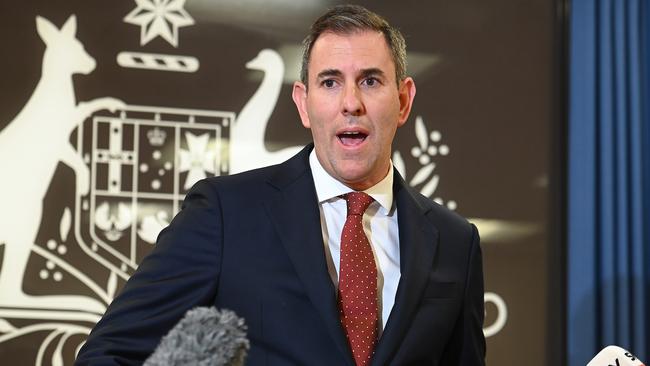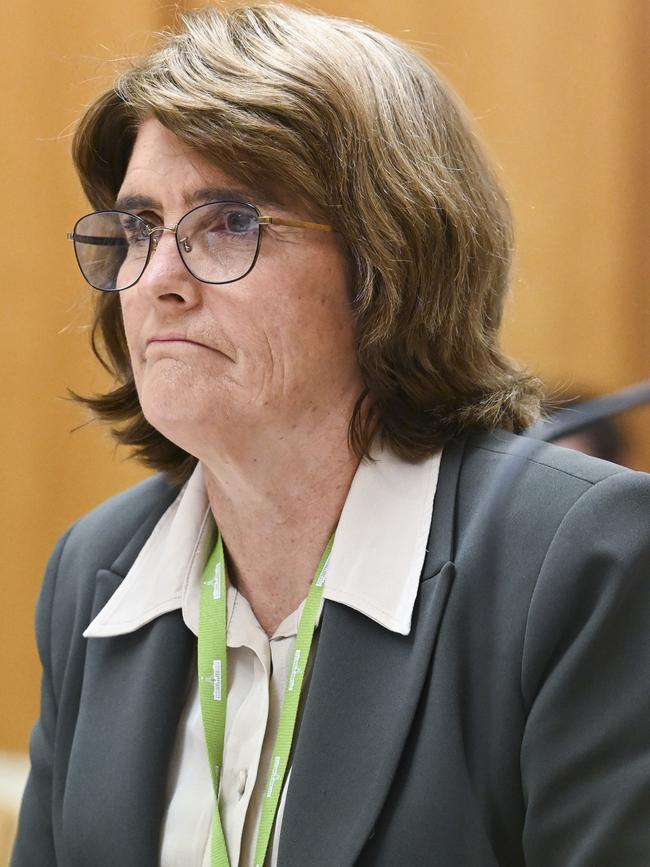Reserve Bank ‘smashing the economy’ via rate hikes, Jim Chalmers declares
Jim Chalmers’ comments shift blame on to the central bank governor, Michele Bullock, ahead of the release of GDP data this week expected to show growth slowing to a crawl.

Jim Chalmers has declared the Reserve Bank is “smashing the economy” with its aggressive run of rate hikes in comments that shift blame on to the central bank governor, Michele Bullock, ahead of data expected to show growth slowing to a crawl.
With increased government spending holding up an economy saddled with anaemic household consumption, faltering business investment and a decline in home building, GDP figures to be released on Wednesday are expected to show the Australian economy expanded by a meagre 0.2 per cent in the June quarter.
This would slash annual economic growth from 1.1 per cent in March to just 0.9 per cent for the last financial year – the weakest annual GDP result since the end of the early 1990s recession outside of the coronavirus pandemic.
GDP per capita is also tipped to slump, marking the sixth consecutive quarter where an increase in the population has outstripped economic growth.
“With all this global uncertainty on top of the impact of rate rises, which are smashing the economy, it would be no surprise at all if the national accounts on Wednesday show growth is soft and subdued,” the Treasurer said. “We anticipated a soft economy at budget time and that’s what most economists now expect to see in these new numbers for the June quarter.”
Dr Chalmers said the government strategy was to strike a balance between taming inflation and providing cost-of-living relief “in an economy already being hammered by higher interest rates and global volatility.”

Since May 2022, the RBA has embarked on its most aggressive tightening cycle since the 1980s, increasing the cash rate 13 times from a record low of 0.1 per cent to its current level of 4.35 per cent as it works to reduce inflation – currently at 3.5 per cent – back to its 2 to 3 per cent target band.
NAB chief economist Alan Oster told The Australian that there was “a serious chance that [GDP growth] could be negative”. Pencilling in an increase of just 0.1 per cent, he said there was “no momentum in the economy and it’s not getting any better”.
With the RBA’s own staff forecasts also tipping a GDP reading in line with consensus forecasts, analysts anticipate Wednesday’s figures are unlikely to spur the RBA to push ahead with rate cuts before the end of the year.
KPMG chief economist Brendan Rynne said he didn’t think there would be “anything in this data that’s going to cause a shock to the Reserve Bank”. “We’ve still got inflation that’s too high and when you look at our real interest rate, it is still relatively more accommodative than what you’re seeing in other jurisdictions, like the United States,” he said.
Investors are betting that the US Federal Reserve will lower its key policy rate in just over two weeks and join central banks in Britain, Canada, New Zealand, Switzerland and the eurozone. However, the RBA is expected to lag its global peers in pushing ahead with rate reductions, with most economists not expecting cuts until 2025.
Opposition Treasury spokesman Angus Taylor said Labor’s “economic mismanagement had left Australia at the back of the pack”. “We are the only G10 nation where core inflation is the same as it was in January,” he said.
Speaking on Friday, RBA deputy governor Andrew Hauser dismissed any chance that the central bank – whose board next meets on September 23-24 – would follow the lead of Fed chair Jerome Powell and cut the cash rate this year. “We’re not yet as confident, as Jay is in the US, that inflation in Australia is back on a sustainable path, back to target. And therefore we have to hold rates where they are for the time being,” Mr Hauser told a podcast hosted by The Conversation.
Across the quarter, household spending is tipped to rise only slightly, with the bulk of the increase attributed to essential purchases. Even as shoppers enjoyed hefty discounts during sales in May and June, retail trade volumes slumped by 0.3 per cent last quarter, the Australian Bureau of Statistics said on Thursday.
Westpac senior economist Pat Bustamante said consumer spending had “broadly flatlined since the December quarter 2022 due to the squeeze on household budgets from bracket creep, higher interest rates and elevated, albeit moderating, inflation.”
Residential construction work completed fell across the quarter as the sector faces sustained pressures from elevated interest rates, alongside ongoing labour and material shortages, with the decline expected to weigh on the June quarter GDP figures.
Also set to drag on the GDP result is a reduction in investment in machinery and equipment by businesses, which slipped 0.5 per cent over the quarter, the ABS reported. Oxford Economics’ Sean Langcake said the “relatively weak” figures indicated that the economy may have contracted in the three months to June.
“Coupled with weakness in retail spending … there is a material chance GDP growth was negative in the quarter,” he said.
Economists will fine tune their forecasts ahead of the national accounts figures on Wednesday with separate ABS data released earlier in the week covering business’ profits and inventories, government expenditure, and Australia’s trade account.
As activity in the private sector remains weak, public spending is expected to play a significant role in driving overall economic growth. After a string of big spending state and federal budgets prompted concerns among economists, Ms Bullock has asserted that public demand is “not the main game” in the central bank’s fight against inflation, a claim that Dr Chalmers has repeated on multiple occasions.
In further evidence of the challenging conditions facing segments of the private sector, the Australian Small Business and Family Enterprise Ombudsman, Bruce Billson, will on Monday reveal a 50 per cent rise in help requests from businesses worried about meeting their financial commitments or dealing with insolvent debtors.
Mr Billson said that payment disputes were the greatest area of concern for small businesses and accounted for 42 per cent of total assistance cases in 2023-24 – up from 36 per cent in the year before.
“The construction industry had the highest number of payment disputes,” he said after the sector was rocked by more than 3800 insolvency appointments last financial year.
Releasing the annual summary of assistance provided to small businesses by the Ombudsman, Mr Billson said there were a total of 6254 requests for assistance in 2023-24, a ten per cent increase on the previous year.
The number of requests for help with insolvency had increased by 50 per cent. “Over the past year, small and family business owners have become increasingly worried about being paid as they face challenging business conditions,” he said. “Many small businesses are drawing on their cash buffers to keep their business afloat. Recent surveys have found nearly one-in-four have no cash reserves while 18 per cent have less than a month’s cash at hand to fulfil their obligations.”
Mr Billson said new figures from the ATO showed that 46 per cent of small businesses did not make a profit in the most recent year of available accounts and three quarters of self-employed business owners were earning less than the average weekly wage.



To join the conversation, please log in. Don't have an account? Register
Join the conversation, you are commenting as Logout